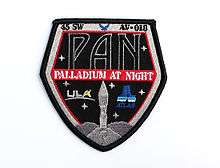USA-207
| Mission type | SIGINT |
|---|---|
| Operator | Classified (presumably NSA) |
| COSPAR ID | 2009-047A |
| SATCAT № | 35815 |
| Spacecraft properties | |
| Bus | A2100 |
| Manufacturer | Lockheed Martin[1] |
| Start of mission | |
| Launch date | 8 September 2009, 21:35:00 UTC[2] |
| Rocket | Atlas V 401 |
| Launch site | Cape Canaveral SLC-41 |
| Contractor | ULA |
| Orbital parameters | |
| Reference system | Geocentric |
| Regime | Geostationary |
| Perigee | 35,778 kilometers (22,231 mi)[3] |
| Apogee | 35,807 kilometers (22,249 mi)[3] |
| Inclination | 0.09 degrees[3] |
| Period | 1436.12 minutes[3] |
| Epoch | 10 January 2015, 14:22:18 UTC[3] |
USA-207,[4] international COSPAR code 2009-047A,[5] also known as PAN, officially meaning Palladium At Night,[6] or P360[7] is a classified American SIGINT satellite,[8] which was launched in September 2009. The US government has not confirmed which of its intelligence agencies will operate the satellite.[9] The spacecraft was constructed by Lockheed Martin, and is based on the A2100 satellite bus,[6] using commercial off-the-shelf components.[7] The contract to build PAN was awarded in October 2006, with the satellite initially scheduled to launch 30 months later, in March 2009.[10]
PAN was launched by United Launch Alliance using an Atlas V 401 carrier rocket, with the serial number AV-018. The launch, from Space Launch Complex 41 at the Cape Canaveral Air Force Station, occurred at 21:35 GMT on 8 September 2009, at the start of a 129-minute launch window.[11] PAN successfully separated from the rocket just under two hours after liftoff.[12]
PAN has shown an unusual history of frequent relocations, moving between at least 9 different orbital slots since launch. With each move, it was placed close to another commercial communications satellite.[8] As of late 2013 it is located at 47.7 deg E., over East Africa.


References
- ↑ Ray, Justin (2009-07-09). "Atlas rocket team continues active year of launches". Spaceflight Now. Retrieved 2009-08-31.
- ↑ McDowell, Jonathan. "Launch Log". Jonathan's Space Page. Retrieved 21 January 2014.
- 1 2 3 4 5 Peat, Chris (10 January 2015). "USA 207 - Orbit". Heavens-Above. Retrieved 25 January 2015.
- ↑ McDowell, Jonathan (2009-09-10). "Issue 615". Jonathan's Space Report. Jonathan's Space Page. Retrieved 2009-09-11.
- ↑ "Spacewarn Bulletin Issue 671". NASA NSSDC. 2009-09-30. Retrieved 2011-07-06.
- 1 2 Day, Dwayne (2009-08-24). "PAN's labyrinth". The Space Review. Retrieved 2009-08-31.
- 1 2 "New Horizons" (PDF). Lockheed Martin. December 2007. p. 7 (5 of PDF). Retrieved 2009-09-06.
- 1 2 Langbroek, Marco (2016-10-31). "A NEMESIS in the sky. PAN, Mentor 4 and close encounters of the SIGINT kind". The Space Review. Retrieved 2016-11-27.
- ↑ Covault, Craig (2009-05-26). "Secret PAN satellite leads Cape milspace launch surge". Spaceflight Now. Retrieved 2009-08-31.
- ↑ "Highlights" (PDF). Lockheed Martin Space Systems Company. Spring 2007. pp. 28 (29 of PDF). Retrieved 2009-09-06.
- ↑ Clark, Stephen. "Worldwide Launch Schedule". Spaceflight Now. Retrieved 2009-08-31.
- ↑ Malik, Tariq (2009-08-30). "Atlas 5 Rocket to Secret Satellite [sic]". Space.com. Archived from the original on 2009-08-31. Retrieved 2009-08-31.